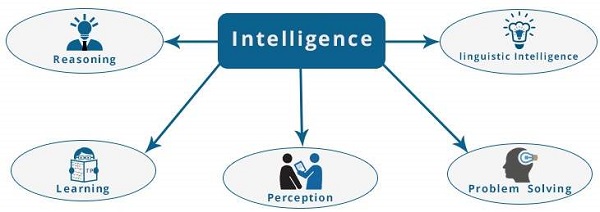📅 最后修改于: 2021-01-23 05:40:26 🧑 作者: Mango
在学习人工智能时,您需要知道什么是智能。本章介绍了智力的概念,智力的类型和组成部分。
什么是智力?
系统具有计算,推理,感知关系和类比,从经验中学习,从内存中存储和检索信息,解决问题,理解复杂思想,流畅地使用自然语言,分类,概括和适应新情况的能力。
智力类型
正如美国发展心理学家霍华德·加德纳(Howard Gardner)所描述的,情报具有多重性-
| Intelligence | Description | Example |
|---|---|---|
| Linguistic intelligence | The ability to speak, recognize, and use mechanisms of phonology (speech sounds), syntax (grammar), and semantics (meaning). | Narrators, Orators |
| Musical intelligence | The ability to create, communicate with, and understand meanings made of sound, understanding of pitch, rhythm. | Musicians, Singers, Composers |
| Logical-mathematical intelligence | The ability of use and understand relationships in the absence of action or objects. Understanding complex and abstract ideas. | Mathematicians, Scientists |
| Spatial intelligence | The ability to perceive visual or spatial information, change it, and re-create visual images without reference to the objects, construct 3D images, and to move and rotate them. | Map readers, Astronauts, Physicists |
| Bodily-Kinesthetic intelligence | The ability to use complete or part of the body to solve problems or fashion products, control over fine and coarse motor skills, and manipulate the objects. | Players, Dancers |
| Intra-personal intelligence | The ability to distinguish among one’s own feelings, intentions, and motivations. | Gautam Buddhha |
| Interpersonal intelligence | The ability to recognize and make distinctions among other people’s feelings, beliefs, and intentions. | Mass Communicators, Interviewers |
您可以说机器或系统中至少装有一个或最多一个智能设备,因此是人工智能。
情报由什么组成?
智力是无形的。它由-组成
- 推理
- 学习
- 解决问题
- 知觉
- 语言智能

让我们简要介绍所有组件-
-
推理-这套流程使我们能够为判断,决策和预测提供基础。大致有两种类型-
| Inductive Reasoning | Deductive Reasoning |
|---|---|
| It conducts specific observations to makes broad general statements. | It starts with a general statement and examines the possibilities to reach a specific, logical conclusion. |
| Even if all of the premises are true in a statement, inductive reasoning allows for the conclusion to be false. | If something is true of a class of things in general, it is also true for all members of that class. |
| Example − “Nita is a teacher. Nita is studious. Therefore, All teachers are studious.” | Example − “All women of age above 60 years are grandmothers. Shalini is 65 years. Therefore, Shalini is a grandmother.” |
-
学习-这是通过学习,练习,教导或体验某些东西来获得知识或技能的活动。学习可以增强对研究主题的认识。
人,某些动物和支持AI的系统具有学习的能力。学习分类为-
-
听觉学习-它是通过听和听来学习。例如,学生听录制的音频讲座。
-
情景学习-通过记忆一个人见证或经历的一系列事件来学习。这是线性且有序的。
-
运动学习-通过精确的肌肉运动来学习。例如,拾取对象,书写等。
-
观察性学习-通过观察和模仿他人来学习。例如,孩子试图通过模仿父母来学习。
-
感知学习-这是学习认识一个人以前见过的刺激。例如,识别和分类对象和情况。
-
关系学习-它涉及学习根据关系属性而不是绝对属性来区分各种刺激。例如,在烹饪上次咸的土豆时添加“少一点”的盐,当煮熟时添加一汤匙的盐。
-
空间学习-它是通过视觉刺激(例如图像,颜色,地图等)进行学习的。例如,一个人可以在实际走这条路之前先在心中创建路线图。
-
刺激反应学习-它是在存在某种刺激时学习执行特定行为的方法。例如,一条狗在听到门铃时举起耳朵。
-
-
解决问题的能力-在这个过程中,人们会通过采取某种途径来感知并尝试从当前状况中获得所需的解决方案,该过程会被已知或未知的障碍所阻止。
解决问题还包括决策,这是从多个备选方案中选择最合适的备选方案以实现所需目标的过程。
-
感知-这是获取,解释,选择和组织感官信息的过程。
知觉假定感觉。在人类中,感觉是由感觉器官协助的。在AI领域,感知机制以有意义的方式将传感器获取的数据组合在一起。
-
语言智能-它是使用,理解,说和写口头和书面语言的能力。这在人际交流中很重要。
人与机器智能之间的区别
-
人类通过模式来感知,而机器通过一组规则和数据来感知。
-
人类通过模式来存储和调用信息,机器通过搜索算法来实现。例如,数字40404040很容易记住,存储和调用,因为它的模式很简单。
-
即使部分物体丢失或变形,人类也可以找出完整的物体。而机器无法正确执行。